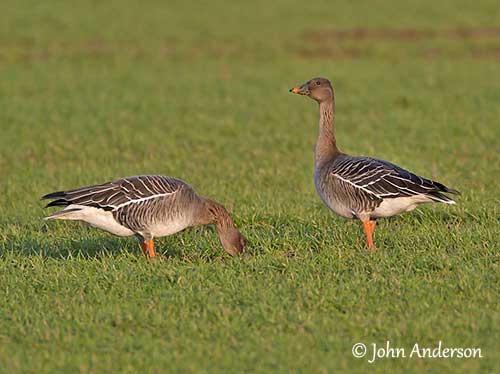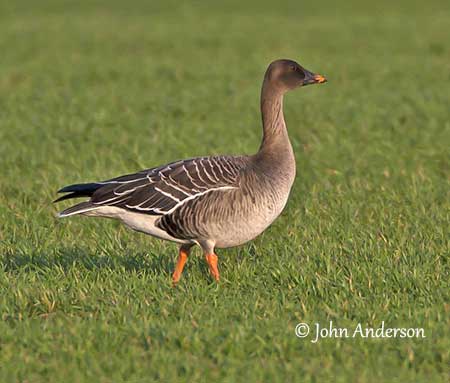
Fr: Oie de la toundra
Ang: Tundra Bean Goose
All: Tundrasaatgans
Ita: Oca granaiola della tundra
Nd: Toendrarietgans
Sd: tundrasädgås
Photographers:
John Anderson
John Anderson Photo Galleries
Text by Nicole Bouglouan
Sources:
HANDBOOK OF THE BIRDS OF THE WORLD vol 1 by Josep del Hoyo-Andrew Elliot-Jordi Sargatal - Lynx Edicions - ISBN: 8487334105
THE HANDBOOK OF BIRD IDENTIFICATION FOR EUROPE AND THE WESTERN PALEARCTIC by Mark Beaman, Steve Madge - C. Helm - ISBN: 0713639601
GUIDE DES CANARDS, DES OIES ET DES CYGNES – de Steve Madge - Delachaux et Niestlé - ISBN: 2603013769
THE COMPLETE BOOK OF BRITISH BIRDS – Written by “Royal Society for the Protection of Birds” experts - Préface de Magnus Magnusson - Michael Cady- Rob Hume Editors - ISBN: 0749509112
A Field Guide to the Birds of South-East Asia by Craig Robson. New Holland Publishers. ISBN: 9781780090498
Focused on fauna (and a little flora)
Rare Birds of North America Par Steve N. G. Howell, Ian Lewington, Will Russell
Gobirding.eu - Tundra Bean Goose Anser (fabalis/serrirostris) rossicus
Birdwatch – The home of birding
The Helm Guide to Bird Identification Par Keith Vinicombe, Alan Harris, Laurel Tucker
Movements of Tundra Bean Goose Anser fabalis rossicus neck-banded in northern Scandinavia
What Bird-The ultimate Bird Guide (Mitchell Waite)
Wikipedia, the free encyclopaedia
Tundra Bean Goose
Anser serrirostris
Anseriformes Order – Anatidae Family
INTRODUCTION:
The Tundra Bean Goose was formerly a subspecies of the Taiga Bean Goose (Anser fabalis). It is a full species since 2007 and has two subspecies, “serrirostris” and “rossicus”. Both races breed in the northern tundra of Russia and Siberia, and winter southwards in Europe and Asia.
The race “rossicus” has currently stable population, whereas the race “serrirostris” is suspected to be declining in some breeding areas.

DESCRIPTION OF THE BIRD:
Biometrics:
Length: 78-89 cm
Wingspan: 162 cm
Weight: 3200 g
The Tundra Bean Goose is larger than A. fabalis and differs in shape and pattern of the bill. The large bill is about 66 mm in male and 63 mm in female (A. fabalis M: 64 mm – F: 60 mm).
The adult has dark brown head and neck. The mantle is paler brown with pale-edged feathers forming large scaled pattern. Back and rump are brownish-black with white band on the sides, and white uppertail-coverts. The tail is dark with white terminal band. On the upperwing, the coverts are grey and the flight feathers are blackish-brown.
On the underparts, breast and belly are pale brownish and flanks are barred dark brown. Vent and undertail-coverts are white. The underwing is greyish-black.
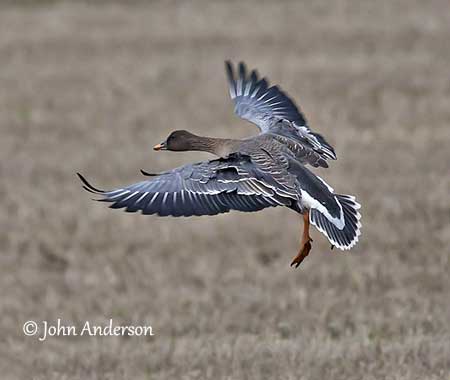
The relatively short, deep-based bill is blackish-brown at base and tip, whereas the orange area is restricted to a subterminal band. There is sometimes some white feathering at base of bill. The eyes are dark brown. Legs and webbed feet are orange.
Male and female have similar plumage, but the male is larger than the female.
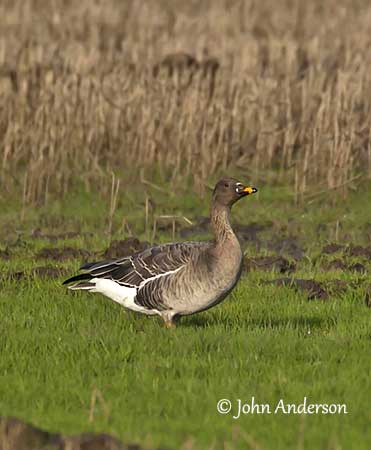
The juvenile resembles adult but it is duller, especially on head and neck that are paler than in adults. On the upperparts, the scaling is heavier, and the feather’s fringes are browner instead of whitish.
There is no white at bill base. The orange area of the bill and also legs and feet are duller and greyer than in adults. It can breed at 2-3 years old.
SUBSPECIES AND RANGE:
The Tundra Bean Goose has two subspecies.
A.s. rossicus (displayed) breeds in tundra of N Russia and NW Siberia, from Kanin Peninsula, E to Taymyr Peninsula. It winters in W and C Europe and SW Asia.
This race is smaller than nominate.
A.s. serrirostris (described above) breeds in tundra of NE Siberia, from Lena Delta E to Anadyrland. It winters in Japan and Korea.
HABITAT:
The Tundra Bean Goose breeds in wet tundra, on lakes, pools or rivers in High Arctic. It winters mostly in marshes and cultivated areas, paddyfields, pastures and fields in Japan and Korea, and usually favours maritime areas.
CALLS AND SONGS: SOUNDS BY XENO-CANTO
The Tundra Bean Goose is usually less noisy than other “Anser” geese, even while in flocks during winter. The usual contact call is a “hank-hank” or “wink-wink” given in flight.
Its voice is more penetrating than that of the Greylag Goose.
BEHAVIOUR IN THE WILD:
The Tundra Bean Goose feeds mainly on plant material including grasses and sedges, cultivated grain (corn), beans (giving the bird its name), carrots and potatoes. Berries are also taken during the breeding season.
It feeds on the ground by grazing and pecking at food items in pastures and crop fields, and spends little time in the water.
The Tundra Bean Goose is usually gregarious and may join other geese, but the flocks are often smaller than in other species.
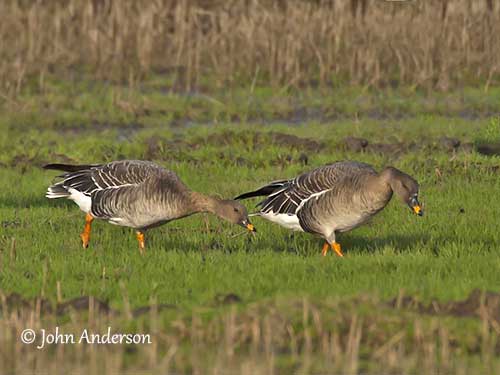
Due to hard weather conditions often involving lack of food, the whole breeding cycle cannot take place on the breeding grounds. Pair formation and courtship displays are performed on the wintering areas and during the return migration.
The Tundra Bean Goose is monogamous and probably with long-term pair bonds. The copulation takes usually place on the water after some ritual displays. After mating, the male stretches its neck while uttering a loud call. It may sometimes spread its wings fully during the “triumph-ceremony” that is very common among geese.
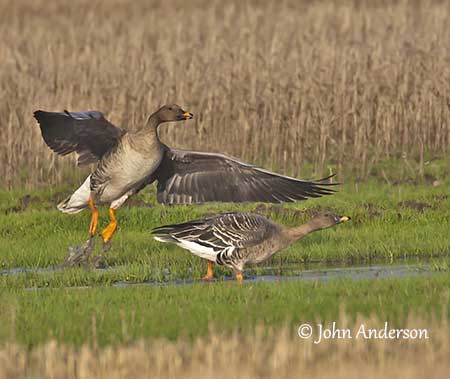
The Tundra Bean Goose is migratory and moves S to reach more temperate regions to spend the winter.
The race “serrirostris” moults on W Coast of Kamchatka, and winters in Japan and Korea. It wanders to the Aleutians, Pribilof, Bering Sea Islands, Yukon Territories and Quebec.
These birds may cover up to 600-700 kilometres in non-stop flight.
The race “rossicus” forms large moulting flocks on Novaya Zemlya and on New Siberian Islands to W Taymyr Peninsula and also Varanger Peninsula in Norway.
The Tundra Bean Goose has strong, direct flight with steady wingbeats. During the migration, they often adopt a typical V formation.
REPRODUCTION OF THE BIRD:
The breeding season starts in May/June. The race “rossicus” lays between 5 and 15 June in arctic Russia.
The Tundra Bean Goose may nest in single pairs or in loose groups. The nest is made with vegetation and lined with down. It is placed in natural depression or scrape on the ground. They nest on dry hummocks on mossy tundra, close to river floodplains.
The female lays 4-6 creamy-white eggs and incubates alone. The incubation may vary from 25 to 29 days. At hatching, the chicks have olive-brown down above and yellowish below. Bill legs and feet are dark grey. They fledge between 7 and 13 weeks according to the subspecies. They remain in family group until the following spring.
The nests are predated by Arctic Foxes and lemmings.
PROTECTION / THREATS / STATUS:
The Tundra Bean Goose has from suffered hunting pressure in the past. Habitat loss through oil pollution, drainage of wetlands, changing management practices and forest clearance are threats in Russia, Norway and Sweden. In addition, the geese also suffer from human persecution, and are vulnerable to pesticides used in cultivated fields where they forage.
The race “rossicus” was estimated at 600,000 individuals in 1990s. It is suspected to be declining.
The race “serrirostris” is declining too. The population was estimated at 45,000/65,000 individuals in 1990s. This race is ranked Vulnerable.
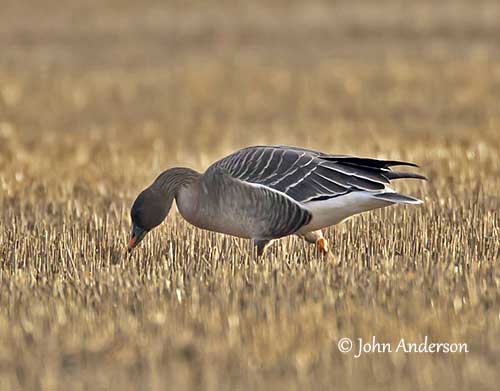
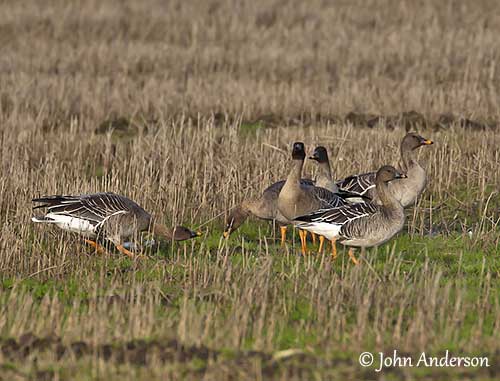
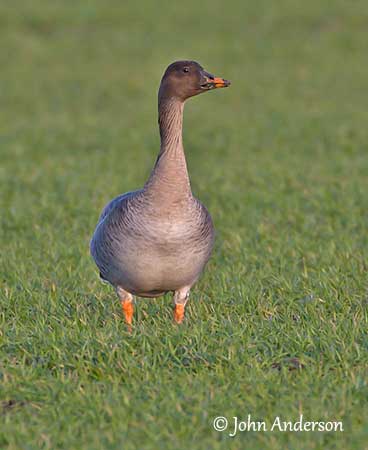
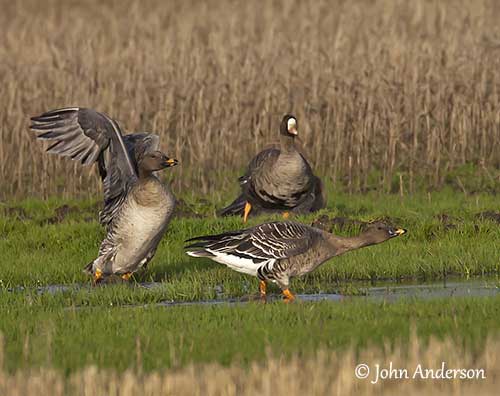
in the background
